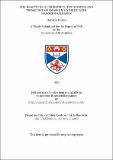Files in this item
The reactions of trimethyl tin hydride and trimethyl germanium hydride with halogenaoalkanes
Item metadata
| dc.contributor.author | Coates, David A. | |
| dc.coverage.spatial | ix, 137 p. | en_US |
| dc.date.accessioned | 2018-07-04T10:48:43Z | |
| dc.date.available | 2018-07-04T10:48:43Z | |
| dc.date.issued | 1972 | |
| dc.identifier.uri | https://hdl.handle.net/10023/14908 | |
| dc.description.abstract | This thesis deals with the abstraction of halogen atoms by trimethyl tin and trimethyl germanium radicals. Part I deals with the reactions of trimethyl tin radicals, produced by the photolysis of trimethyl tin hydride, in the presence of halogeno alkanes. Part II similarly deals with halogen abstraction using trimethyl germanium radicals produced by photolysis of trimethyl germanium hydride. A free radical chain mechanism appears to be operative in which a reaction scheme of the following form has been postulated. CH₃)₃M• + RX □(→┴(k₂) ) (CH₃)₃MX + R• R• + (CH₃)₃MH □(→┴(k₃) ) (CH₃)₃M•+ RH (CH₃)₃M• + (CH₃)₃M• □(→┴(k₄) ) (CH₃)₃M-M(CH₃)₃ (M = Sn or Ge) Evidence supporting this mechanism includes the dependence of the formation of the alkane on the ½Type equation here. power of the light intensity, the non-existence of any other termination products and the thermodynamics of the overall initiation and propagation steps. The observed trends in abstraction rates, Br > C1 > F and for a particular halide tertiary > secondary > primary, are predicted by bond energy data and confirmed experimentally. Breaking of the C-X bond is hence of major importance in determining the relative rates of abstraction. Polar effects have been discussed in terms of the four factors put forward by Tedder and the properties of these two nucleophilic radicals have been discussed in terms of Coulombic repulsive and attractive forces due to electron displacement in the transition state. The change in reactivity, following substitution by electron withdrawing groups at the reaction site, provides evidence for the reversal of polar effects in the transition state. Substitution with electron withdrawing groups decreases the activation energy for halogen abstraction by trimethyl tin and trimethyl germanium radicals. However for hydrogen abstraction by chlorine atoms or trifluoromethyl radicals the activation energy is increased. | en_US |
| dc.language.iso | en | en_US |
| dc.publisher | University of St Andrews | |
| dc.subject.lcc | QD305.H15F2 | |
| dc.subject.lcsh | Organofluorine compounds | en |
| dc.title | The reactions of trimethyl tin hydride and trimethyl germanium hydride with halogenaoalkanes | en_US |
| dc.type | Thesis | en_US |
| dc.contributor.sponsor | Science Research Council (Great Britain) | en_US |
| dc.type.qualificationlevel | Doctoral | en_US |
| dc.type.qualificationname | PhD Doctor of Philosophy | en_US |
| dc.publisher.institution | The University of St Andrews | en_US |
This item appears in the following Collection(s)
Items in the St Andrews Research Repository are protected by copyright, with all rights reserved, unless otherwise indicated.

